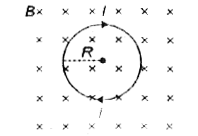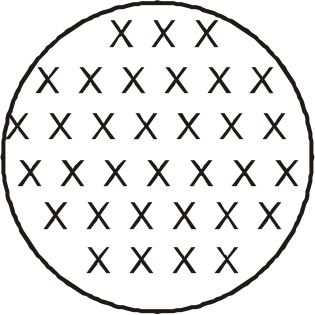A closed loop of →B is produced by a changing electric field. Does it necessarily mean that →E and d→E/dt are non-zero at all points on the loop and in the area enclosed by the loop?
To address the question, we need to analyze the relationship between the changing electric field and the induced magnetic field in the context of electromagnetic theory.
1. Understanding the Concept:
- According to Faraday's law of electromagnetic induction, a changing electric field can induce a magnetic field. This is expressed mathematically as:
→B=−dΦEdt
where ΦE is the electric flux through a surface bounded by the loop.
2. Electric Flux Definition:
- The electric flux ΦE through a surface is given by:
ΦE=∫→E⋅d→A
where →E is the electric field and d→A is the differential area vector.
3. Condition for Induced Magnetic Field:
- For a magnetic field →B to be induced, the electric flux ΦE must be changing with time:
dΦEdt≠0
- This does not imply that the electric field →E must be non-zero at every point on the loop or within the enclosed area.
4. Non-Zero Electric Field:
- It is possible for the electric field →E to be zero at certain points on the loop or in the enclosed area while still having a changing electric flux. This can occur if the electric field varies in such a way that the total flux through the loop changes even if the field at some points is zero.
5. Conclusion:
- Therefore, it is not necessary for both →E and d→Edt to be non-zero at all points on the loop or in the area enclosed by the loop for a magnetic field →B to be produced. The key requirement is that the total electric flux ΦE through the loop must be changing with time.
Final Answer:
No, it is not necessary that →E and d→Edt are non-zero at all points on the loop and in the area enclosed by the loop. The only requirement is that the total electric flux ΦE through the loop must vary with time.
---
- According to Faraday's law of electromagnetic induction, a changing electric field can induce a magnetic field. This is expressed mathematically as:
→B=−dΦEdt
where ΦE is the electric flux through a surface bounded by the loop.
- The electric flux ΦE through a surface is given by:
ΦE=∫→E⋅d→A
where →E is the electric field and d→A is the differential area vector.
- For a magnetic field →B to be induced, the electric flux ΦE must be changing with time:
dΦEdt≠0
- This does not imply that the electric field →E must be non-zero at every point on the loop or within the enclosed area.
- It is possible for the electric field →E to be zero at certain points on the loop or in the enclosed area while still having a changing electric flux. This can occur if the electric field varies in such a way that the total flux through the loop changes even if the field at some points is zero.
- Therefore, it is not necessary for both →E and d→Edt to be non-zero at all points on the loop or in the area enclosed by the loop for a magnetic field →B to be produced. The key requirement is that the total electric flux ΦE through the loop must be changing with time.
No, it is not necessary that →E and d→Edt are non-zero at all points on the loop and in the area enclosed by the loop. The only requirement is that the total electric flux ΦE through the loop must vary with time.
Topper's Solved these Questions
- ELECTROMAGNETIC WAVESBOOK - PRADEEPCHAPTER - ELECTROMAGNETIC WAVESEXERCISE - Value based questions
5 Videos
- ELECTROMAGNETIC WAVESBOOK - PRADEEPCHAPTER - ELECTROMAGNETIC WAVESEXERCISE - Exercise
132 Videos
- ELECTROMAGNETIC WAVESBOOK - PRADEEPCHAPTER - ELECTROMAGNETIC WAVESEXERCISE - long answer question
3 Videos
- ELECTROMAGNETIC INDUCTION & ALTERNATING CURRENTBOOK - PRADEEPCHAPTER - ELECTROMAGNETIC INDUCTION & ALTERNATING CURRENTEXERCISE - Multiple Choice Questions
1 Videos
- ELECTRONIC DEVICESBOOK - PRADEEPCHAPTER - ELECTRONIC DEVICESEXERCISE - Fill in the Blanks
1 Videos
Similar Questions
If you find closed loops of →B in a region in space, does it necessarily mean that actual charges are flowing across the area bounded by the loops ?
View Solution(a) A closed loop is held stationary in the magnetic field between the north and south poles of two permanent magnets held fixed. Can we hope to generate current in the loop by using very strong magnets?
(b) A closed loop moves normal to the constant electric field between the plates of a large capacitor. Is a current induced in the loop (i) when it is wholly inside the region between the capacitor plates (ii) when it is partially outside the plates of the capacitor? The electric field is normal to the plane of the loop.
(c) A rectangular loop and a circular loop are moving out of a uniform magnetic field region (Fig. 6.8) to a field-free region with a constant velocity v. In which loop do you expect the induced emf to be constant during the passage out of the field region? The field is normal to the loops.

(d) Predict the polarity of the capacitor in the situation described by Fig. 6.9.

View Solution
Knowledge Check
It is known to you that ''whenever the flux of a magnetic field through the area bound by a closed conducting loop changes , an emf is produced in the loop . Then emf is given by ε=−dϕdt , where ψ=∫→B.→ds is the flux of the magnetic flux through a closed loop changes, an electric current results. Let us now investigate " what is the external mechanism that maintains the electric field in the loop to drive the current". In the words what is the mechanism to produce an emf? (a) keeping ther magnetic field constant as time pases and moving whole as part of the loop.
(b) Keeping the loop at rest and changing the magnetic field.
(c) Combination of (a) and (b)that is by moving the loop ( partly or wholly) as well as by changing the field. The mechanism (a) for production of emf is studie under the heating motional emf and mechanism (b) under the heating induced electric field.
In mechanism (a) , magnitude of the potential difference across the conductor is given by ε=Blv where,B,l, v have their usual meanings and the electrostatic field developed within the conductor E=vB
Whereas if the magnetic field through a stationary conduting loop is changing with time, then also there will be an induced emf whose value will be ε=∮→E.→dl, where E is the induced electric field. The electric field produced by the changing magnetic field is non-electrostatic and non-conservation
If the above magnetic field is present perpendicular to a ring of radius of 1 cm, mass=10 gram and charge =1 C, then the angular velocity of the ring as a function of time is ( the ring and the cylinderical region are coaxial)A(6t2+12)×102 rad/sB(3t2+24)×102 rad/sC(t2+12t)×102 rad/sD(3t2+4)×102 rad/sSuppose an isolated north pole is kept at the centre of a circular loop carrying a electric current i. The magnetic field due to the north pole at a point on the periphery of the wire is B. The radius of the loop is a . The force on the wire is
ANearly 2πaIB perpendicular to the plane of the wireB2πaIB in the plane of the wireCπaiB along the axis of the wireDzeroAn electric current can be produced in a closed loop
Aby connecting it to a battery, but not by moving a magnet near itBBy moving a magnet near the loop, but not by connecting a batteryCBy connecting it to a battery, as well as by moving a magnet near itDneither by connecting a battery nor by moving a magnet near it
A square loop of wire, edge length a, carries a current i. Compute the magnitude of the magnetic field produced at a point on the axis of the loop at a distance x from the centre.
View SolutionIf for an Amperian loop ∮→B.→dl=0 does that mean →B=0 at every point on the Amperian loop ?
View SolutionA square loop of side 20 cm is placed on a plane and magnetic field intensity of 0.1 T is applied at an angle 30 with the plane of the loop. Magnetic field is changed to zero uniformly within 0.8 second. Calculate the emf induced in the loop.
View SolutionA circular loop of radius R is kept in a uniform magnetic field pointing perpendicular into the plane of paper. When a current l flows in the loop, the tension produced in the loop is

View SolutionConsider a conducting circular loop placed in a magentic filed as shown. When magnetic field changes with time, magentic flux also changes and emf is induced.
e=−dϕdt
If resistance of loop is R then induced current.
i=eR
For Current, charge must have come into motion. Magnetic force cannot make the statinoary charges to move. Actually there is an induced electric field in the conductor caused by changing magnetic flux, which make the change to move
∫→E.d→l=e=−dϕdt
This induced electric field is non-electrostatic by nature. line integral of →E around a closed path is non-zero

Refer to above questions, Find the magnitude of line integral of induced electric field along path CD.
View Solution
